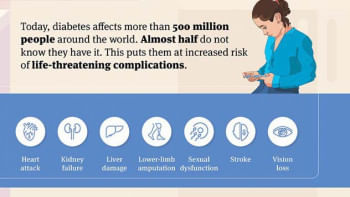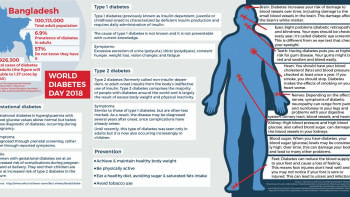Diabetes turning into a killer epidemic

It is quite alarming that one in every 10 persons in the world now lives with diabetes, as revealed by the International Diabetes Federation (IDF). More than 500 million people have been affected by it, but unfortunately, almost half of them are reportedly undiagnosed. In case of Bangladesh, the IDF estimated last year that 13.1 million people were living with diabetes, and projected the number to be almost double by 2025. This is extremely concerning, as diabetes is one of the four major types of non-communicable diseases (NCDs) that make the largest contribution to morbidity and mortality worldwide.
Naturally, the explosion of diabetes has been putting health systems under increasing pressure, preventing people who have contracted the disease and those who are at risk from getting the care and education they need. This, in turn, is increasing the number of diabetic patients – forming a deadly cycle. Needless to say, Bangladesh is also in the same boat, and with the number of diabetic patients expected to double in only three years, its healthcare system will continue to suffer.
Therefore, while it is essential for the government to increase the number of doctors, nurses, and other staff to deal with the increased number of patients – and to equip them with better tools to provide proper care – ultimately, it might prove to be a losing battle unless preventive measures are immediately taken.
With that in mind, along with the fact that diabetes is linked with other non-communicable diseases, we urge the authorities to comply with the Diabetic Association of Bangladesh's call to urgently adopt a national plan of action to tackle diabetes, for which a cure is yet to be discovered. Central to that is building awareness among people that diabetes is increasing due to rapid urbanisation, changes in lifestyle and food habit, and lack of physical labour. Additionally, people should know that it is a life-threatening disease that may have a prolonged negative impact on the patient and family, as well as on the economy in general. Therefore, every individual should consciously make better lifestyle decisions, eat healthier food – and refrain from unhealthy ones – as well as take up regular exercise.
There is one positive development in this regard, however. Bangladeshi researchers have come up with a test to identify people likely to develop type-2 diabetes in the future, making prevention all the more possible. Currently, the Directorate General of Drug Administration (DGDA) is reviewing the approval application for the kit, and we hope the government gives special emphasis towards its proper development.
Investing in the project could save countless lives, which could indeed prove to be priceless. Such a breakthrough in predicting the probability of someone contracting diabetes could not only change the fate of thousands of individuals and families in our own country, but also millions around the world. Therefore, the public and private sectors should join hands to ensure this project succeeds without any hiccups, and to improve our overall diabetes preparedness.

 For all latest news, follow The Daily Star's Google News channel.
For all latest news, follow The Daily Star's Google News channel. 







Comments